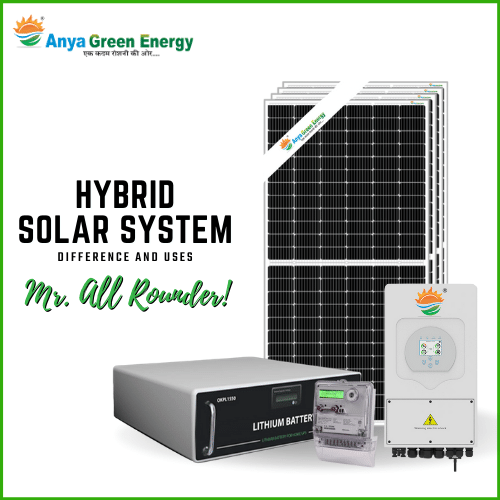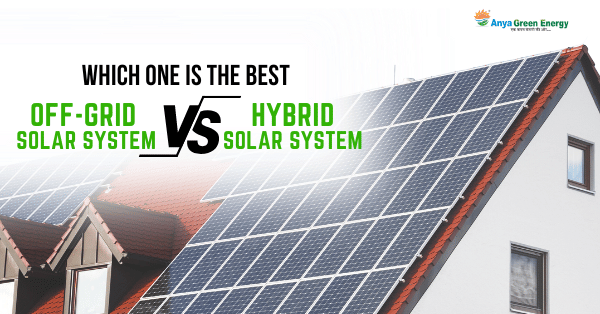HYBRID SOLAR SYSTEM FOR RUBBER INDUSTRY
The rubber industry has long been associated with energy-intensive operations, often reliant on conventional power sources that contribute to environmental degradation and escalating operational costs. However, as we stand on the cusp of a more sustainable future, it’s time for a paradigm shift.
The integration of hybrid solar system for rubber industry is a transformative step towards achieving energy efficiency and environmental responsibility. In this blog, we’ll delve into the potential of hybrid solar systems for the rubber industry, exploring why they are the optimal choice for sustainable production.
GET HYBRID SOLAR SYSTEM FOR RUBBER INDUSTRY

Why choose hybrid solar system for rubber industry ?
The rubber industry, a cornerstone of modern manufacturing, heavily relies on energy to power its various processes. These processes, which include mixing, molding, vulcanization, and more, consume substantial amounts of energy. Conventional energy sources, such as fossil fuels, not only contribute to environmental degradation but also come with unpredictable cost fluctuations.
Here’s why the rubber industry should opt for hybrid solar systems:
Energy Efficiency: Hybrid solar systems harness the power of the sun, providing a consistent and reliable source of clean energy. This ensures the rubber industry’s energy needs are met efficiently, reducing the risk of power interruptions.
Cost Savings: By integrating solar energy, rubber manufacturers can significantly cut their energy bills. The initial investment in solar panels and hybrid technology often pays for itself over time as energy savings accumulate.
Adaptability: Hybrid solar systems are designed to seamlessly transition between solar and conventional power, making them adaptable to the rubber industry’s fluctuating energy demands. This flexibility ensures continuous operations and minimizes downtime.
Environmental Responsibility: Embracing solar energy aligns with global environmental goals, allowing the rubber industry to reduce its carbon footprint and contribute to a sustainable future. This eco-friendly approach can attract environmentally conscious customers and partners.
Energy Independence: Hybrid solar systems provide a degree of energy independence, reducing the rubber industry’s vulnerability to energy price fluctuations and supply chain disruptions. This is crucial for consistent operations, even in challenging economic climates.
Compliance and Incentives: Many governments worldwide offer incentives and tax breaks to businesses that adopt renewable energy sources. By installing hybrid solar systems, rubber manufacturers may qualify for these incentives, further boosting their economic viability.
Technological Advancements: Solar technology continues to evolve rapidly, resulting in increasingly efficient and cost-effective hybrid systems. This means that rubber industry players can benefit from ongoing advancements in the field.

Importance of hybrid solar system for rubber industry
The importance of hybrid solar system for rubber industry cannot be overstated. Traditional energy sources, such as fossil fuels, not only contribute to environmental degradation but also incur exorbitant operational costs. By integrating solar energy, businesses can substantially decrease their reliance on non-renewable resources while insulating themselves from the volatility of energy markets.
This transition towards sustainable energy practices not only aligns with global environmental goals but also future-proofs businesses against rising energy costs.
Here are some key aspects of the importance of hybrid solar system for rubber industry:
Sustainability: The rubber industry is a significant contributor to carbon emissions due to its energy-intensive operations. The adoption of hybrid solar systems allows manufacturers to reduce their carbon footprint, helping combat climate change and aligning with sustainability goals.
Cost Control: The rubber industry faces constant fluctuations in energy costs, impacting its operational expenses. Hybrid solar systems offer a degree of control over energy expenses, providing predictability and reducing financial risks.
Operational Continuity: The adaptability of hybrid solar systems ensures that the rubber industry can continue production even in the event of power outages or disruptions in the energy supply. This operational continuity is vital for meeting production deadlines and maintaining customer satisfaction.
Economic Viability: The rubber industry’s adoption of renewable energy sources such as hybrid solar systems can make it eligible for government incentives, subsidies, and tax benefits, further enhancing its economic viability.
Environmental Responsibility: Taking proactive steps to reduce environmental impact enhances a company’s image and attracts environmentally conscious consumers and partners. Embracing solar energy demonstrates a commitment to sustainable practices.
Benefits of hybrid solar system for rubber industry
The advantages of integrating a hybrid solar system for rubber industry are manifold. Let’s explore these benefits in greater detail:
Cost Efficiency: Hybrid solar systems offer a cost-effective solution for the rubber industry. By harnessing solar power, companies can significantly reduce their energy bills, providing an immediate return on investment. Moreover, excess energy can be stored or sold back to the grid, creating an additional revenue stream.
Reduced Environmental Impact: One of the most compelling benefits of hybrid solar system for rubber industry is their ability to curtail carbon emissions. By relying on clean, renewable energy, businesses can drastically minimize their environmental footprint, contributing to a more sustainable future.
Energy Independence: With a hybrid solar system in place, rubber manufacturers gain a degree of energy independence. This reduces their vulnerability to energy price fluctuations and supply chain disruptions, ensuring consistent operations even in challenging economic climates.
Enhanced Corporate Image: Embracing sustainable practices through the adoption of a hybrid solar system speaks volumes about a company’s commitment to environmental responsibility. This can enhance its reputation, attracting eco-conscious customers and partners.
Compliance and Incentives: Governments around the world are offering incentives and tax breaks to businesses that adopt renewable energy sources. By installing a hybrid solar system, rubber manufacturers may qualify for various incentives, further boosting their economic viability.
Technological Advancements: The rapid evolution of solar technology ensures that hybrid systems continue to become more efficient and cost-effective over time. This means that businesses can benefit from ongoing advancements in the field.
The integration of a hybrid solar system for rubber industry is nothing short of a game-changer. It not only aligns with global efforts to combat climate change but also offers a host of tangible benefits for businesses. From cost savings and reduced environmental impact to enhanced corporate image and energy independence, the advantages are clear.
As the world moves towards a more sustainable future, embracing this innovative technology is not just a choice but a necessity for the rubber industry. By harnessing the power of the sun, businesses can illuminate a brighter, more sustainable path forward. Embrace the potential of a hybrid solar system for your rubber industry operations today, and be a part of the green revolution that’s shaping the future.


